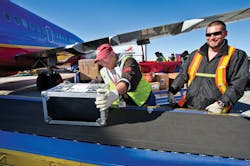Southwest Airlines Cargo Introduces Cargo Companion
One of the most important factors in shipping is getting a product to its destination as quickly as possible, but just as important are the conditions in which the cargo is shipped. From items improperly handled, damaged or even lost, the thought that anything can happen from the time a product leaves the shipper’s hands to the time it arrives at its final destination is a cause of stress and worry for many who frequently ship important cargo.
Many airlines are doing their best to alleviate this concern for their customers. Asset tracking technology for air cargo typically starts and stops in the plane’s cargo hold. Southwest Airlines Cargo, however, just took this technology much further with its Cargo Companion.
The 12-ounce wireless electronic device is about the size of a smart phone making it easy to pack in with the shipment.
“It includes sensors that read temperature, humidity, pressure, shock, location and vibration with additional intelligence that tracks other conditions and the location of the package,” says Colin Rogers, senior manager of specialty sales for Southwest Airlines Cargo.
What makes the Cargo Companion different from other asset tracking devices is what Rogers refers to as “cradle-to-grave tracking.”
The device has the ability to monitor cargo not only in the air, but on the ground as well. In fact, the cargo is tracked right up to delivery, giving the customer complete visibility regarding their cargo for the duration of the shipment. It also gives Southwest Airlines Cargo full chain-of-supply tracking for cargo on all of its flights.
These sensors alert the customer if storage conditions become unfavorable or if damage occurs en route. Location tracking technology helps pinpoint the cargo every inch of the way. The Cargo Companion even includes light sensors that identify if and when a package has been opened prior to delivery.
E-mail alerts are sent as the cargo reaches various checkpoints along its journey, such as origin airport, destination airport and final destination, so the customer is always up to date on the status of shipped items. Tracking by air waybill is also provided, allowing the customer to view the shipment status online at www.swacargo.com.
The Cargo Companion’s number is added to the customer’s air waybill, and instructions for returning the device are included.
“These devices have already been used very satisfactorily within the general transportation industry, but this technology is relatively new to the air freight sector,” Rogers adds.
The Cargo Companion adheres to all criteria set by the FAA. It is even able to switch into a special setting upon take off in order to comply with FAA regulations on “switching off all electronic devices” while continuing to monitor and update the status of the cargo.
“A feature allows the device to automatically go into airplane mode, turning its wireless radios off without human intervention,” Rogers says. “But at the same time, the sensors keep working to monitor the cargo.”
Abbie Reetz was a summer intern for not only Ground Support Worldwide, but Airport Business and AMT.
Door-To-Door Tracking
Southwest Airlines Cargo spent a year testing the Cargo Companion to make sure the technology works in the air, on the ground and right up to the point the shipment is signed for.
“We’re seeing a steady increase in demand for medical and pharmaceutical shipments, which require cold-chain procedures,” says Wally Devereaux, director of sales and marketing for Southwest Airlines Cargo. The device is only available for cargo customers using the airline's "Next Flight Guaranteed Service."
"Same-day commercial air cargo is the fastest and most efficient means for shipping these types of products,” he adds.
Specialty logistics and transportation companies such as LaserShip and Quick International Courier have already been used the Cargo Companion to ship organs, blood, bone marrow and tissue for transplant or research, all of which require strict adherence to cold-chain protocol.
In addition to its many tracking capabilities, the device can also send out breakage or temperature early-warning that allow the shippers more time if they need to arrange an alternate plan.
These early warnings are an important feature according to Marie Vigliarolo, vice president of marketing for Quick International Courier.
“For every shipment, we need a plan B and even a plan C,” she says. “If a problem occurs during transit, every second is precious and the technology buys us time to jumpstart a contingency plan.”
